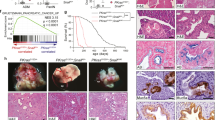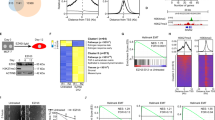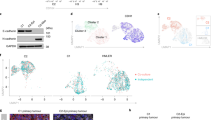Abstract
Epithelial to mesenchymal transition (EMT) is implicated in the progression of primary tumours towards metastasis and is likely caused by a pathological activation of transcription factors regulating EMT in embryonic development. To analyse EMT-causing pathways in tumourigenesis, we identified transcriptional _targets of the E-cadherin repressor ZEB1 in invasive human cancer cells. We show that ZEB1 repressed multiple key determinants of epithelial differentiation and cell–cell adhesion, including the cell polarity genes Crumbs3, HUGL2 and Pals1-associated tight junction protein. ZEB1 associated with their endogenous promoters in vivo, and strongly repressed promotor activities in reporter assays. ZEB1 downregulation in undifferentiated cancer cells by RNA interference was sufficient to upregulate expression of these cell polarity genes on the RNA and protein level, to re-establish epithelial features and to impair cell motility in vitro. In human colorectal cancer, ZEB1 expression was limited to the tumour–host interface and was accompanied by loss of intercellular adhesion and tumour cell invasion. In invasive ductal and lobular breast cancer, upregulation of ZEB1 was stringently coupled to cancer cell dedifferentiation. Our data show that ZEB1 represents a key player in pathologic EMTs associated with tumour progression.
This is a preview of subscription content, access via your institution
Access options
Subscribe to this journal
Receive 50 print issues and online access
We are sorry, but there is no personal subscription option available for your country.
Buy this article
- Purchase on SpringerLink
- Instant access to full article PDF
Prices may be subject to local taxes which are calculated during checkout





Similar content being viewed by others
References
Batlle E, Sancho E, Franci C, Dominguez D, Monfar M, Baulida J et al. (2000). The transcription factor snail is a repressor of E-cadherin gene expression in epithelial tumour cells. Nat Cell Biol 2: 84–89.
Bilder D . (2004). Epithelial polarity and proliferation control: links from the Drosophila neoplastic tumor suppressors. Genes Dev 18: 1909–1925.
Brabletz T, Jung A, Reu S, Porzner M, Hlubek F, Kunz-Schughart LA et al. (2001). Variable beta-catenin expression in colorectal cancers indicates tumor progression driven by the tumor environment. Proc Natl Acad Sci USA 98: 10356–10361.
Brabletz T, Jung A, Spaderna S, Hlubek F, Kirchner T . (2005). Opinion: migrating cancer stem cells – an integrated concept of malignant tumour progression. Nat Rev Cancer 5: 744–749.
Brumby AM, Richardson HE . (2005). Using Drosophila melanogaster to map human cancer pathways. Nat Rev Cancer 5: 626–639.
Cano A, Perez-Moreno MA, Rodrigo I, Locascio A, Blanco MJ, del Barrio MG et al. (2000). The transcription factor snail controls epithelial-mesenchymal transitions by repressing E-cadherin expression. Nat Cell Biol 2: 76–83.
Chua HL, Bhat-Nakshatri P, Clare SE, Morimiya A, Badve S, Nakshatri H . (2006). NF-kappaB represses E-cadherin expression and enhances epithelial to mesenchymal transition of mammary epithelial cells: potential involvement of ZEB-1 and ZEB-2. Oncogene 26: 711–724.
Comijn J, Berx G, Vermassen P, Verschueren K, van Grunsven L, Bruyneel E et al. (2001). The two-handed E box binding zinc finger protein SIP1 downregulates E-cadherin and induces invasion. Mol Cell 7: 1267–1278.
Condeelis J, Pollard JW . (2006). Macrophages: obligate partners for tumor cell migration, invasion, and metastasis. Cell 124: 263–266.
De Craene B, Gilbert B, Stove C, Bruyneel E, van Roy F, Berx G . (2005a). The transcription factor snail induces tumor cell invasion through modulation of the epithelial cell differentiation program. Cancer Res 65: 6237–6244.
De Craene B, van Roy F, Berx G . (2005b). Unraveling signalling cascades for the Snail family of transcription factors. Cell Signal 17: 535–547.
Dohadwala M, Yang SC, Luo J, Sharma S, Batra RK, Huang M et al. (2006). Cyclooxygenase-2-dependent regulation of E-cadherin: prostaglandin E(2) induces transcriptional repressors ZEB1 and snail in non-small cell lung cancer. Cancer Res 66: 5338–5345.
Eger A, Aigner K, Sonderegger S, Dampier B, Oehler S, Schreiber M et al. (2005). DeltaEF1 is a transcriptional repressor of E-cadherin and regulates epithelial plasticity in breast cancer cells. Oncogene 24: 2375–2385.
Eger A, Mikulits W . (2005). Models of epithelial-mesenchymal transition. Drug Discovery Today: Disease Models 2: 57–63.
Eger A, Stockinger A, Schaffhauser B, Beug H, Foisner R . (2000). Epithelial mesenchymal transition by c-Fos estrogen receptor activation involves nuclear translocation of beta-catenin and upregulation of beta-catenin/lymphoid enhancer binding factor-1 transcriptional activity. J Cell Biol 148: 173–188.
Grooteclaes ML, Frisch SM . (2000). Evidence for a function of CtBP in epithelial gene regulation and anoikis. Oncogene 19: 3823–3828.
Guaita S, Puig I, Franci C, Garrido M, Dominguez D, Batlle E et al. (2002). Snail induction of epithelial to mesenchymal transition in tumor cells is accompanied by MUC1 repression and ZEB1 expression. J Biol Chem 277: 39209–39216.
Gupta PB, Kuperwasser C, Brunet JP, Ramaswamy S, Kuo WL, Gray JW et al. (2005). The melanocyte differentiation program predisposes to metastasis after neoplastic transformation. Nat Genet 37: 1047–1054.
Hajra KM, Chen DY, Fearon ER . (2002). The SLUG zinc-finger protein represses E-cadherin in breast cancer. Cancer Res 62: 1613–1618.
Huber MA, Kraut N, Beug H . (2005). Molecular requirements for epithelial-mesenchymal transition during tumor progression. Curr Opin Cell Biol 17: 548–558.
Krishnamachary B, Zagzag D, Nagasawa H, Rainey K, Okuyama H, Baek JH et al. (2006). Hypoxia-inducible factor-1-dependent repression of E-cadherin in von Hippel-Lindau tumor suppressor-null renal cell carcinoma mediated by TCF3, ZFHX1A, and ZFHX1B. Cancer Res 66: 2725–2731.
Lacroix M, Leclercq G . (2004). Relevance of breast cancer cell lines as models for breast tumours: an update. Breast Cancer Res Treat 83: 249–289.
Michel D, Arsanto JP, Massey-Harroche D, Beclin C, Wijnholds J, Le Bivic A . (2005). PATJ connects and stabilizes apical and lateral components of tight junctions in human intestinal cells. J Cell Sci 118: 4049–4057.
Moreno-Bueno G, Cubillo E, Sarrio D, Peinado H, Rodriguez-Pinilla SM, Villa S et al. (2006). Genetic profiling of epithelial cells expressing e-cadherin repressors reveals a distinct role for snail, slug, and e47 factors in epithelial-mesenchymal transition. Cancer Res 66: 9543–9556.
Nishimura G, Manabe I, Tsushima K, Fujiu K, Oishi Y, Imai Y et al. (2006). DeltaEF1 mediates TGF-beta signaling in vascular smooth muscle cell differentiation. Dev Cell 11: 93–104.
Ohira T, Gemmill RM, Ferguson K, Kusy S, Roche J, Brambilla E et al. (2003). WNT7a induces E-cadherin in lung cancer cells. Proc Natl Acad Sci USA 100: 10429–10434.
Pacher M, Seewald MJ, Mikula M, Oehler S, Mogg M, Vinatzer U et al. (2006). Impact of constitutive IGF1/IGF2 stimulation on the transcriptional program of human breast cancer cells. Carcinogenesis 28: 49–59.
Palmer HG, Larriba MJ, Garcia JM, Ordonez-Moran P, Pena C, Peiro S et al. (2004). The transcription factor SNAIL represses vitamin D receptor expression and responsiveness in human colon cancer. Nat Med 10: 917–919.
Peinado H, Portillo F, Cano A . (2004). Transcriptional regulation of cadherins during development and carcinogenesis. Int J Dev Biol 48: 365–375.
Pena C, Garcia JM, Garcia V, Silva J, Dominguez G, Rodriguez R et al. (2006). The expression levels of the transcriptional regulators p300 and CtBP modulate the correlations between SNAIL, ZEB1, E-cadherin and vitamin D receptor in human colon carcinomas. Int J Cancer 119: 2098–2104.
Pena C, Garcia JM, Silva J, Garcia V, Rodriguez R, Alonso I et al. (2005). E-cadherin and vitamin D receptor regulation by SNAIL and ZEB1 in colon cancer: clinicopathological correlations. Hum Mol Genet 14: 3361–3370.
Perez-Moreno MA, Locascio A, Rodrigo I, Dhondt G, Portillo F, Nieto MA et al. (2001). A new role for E12/E47 in the repression of E-cadherin expression and epithelial-mesenchymal transitions. J Biol Chem 276: 27424–27431.
Shin K, Straight S, Margolis B . (2005). PATJ regulates tight junction formation and polarity in mammalian epithelial cells. J Cell Biol 168: 705–711.
Spaderna S, Schmalhofer O, Hlubek F, Berx G, Eger A, Merkel S et al. (2006). A transient, EMT-linked loss of basement membranes indicates metastasis and poor survival in colorectal cancer. Gastroenterology 131: 830–840.
Spoelstra NS, Manning NG, Higashi Y, Darling D, Singh M, Shroyer KR et al. (2006). The transcription factor ZEB1 is aberrantly expressed in aggressive uterine cancers. Cancer Res 66: 3893–3902.
Thiery JP . (2002). Epithelial-mesenchymal transitions in tumour progression. Nat Rev Cancer 2: 442–454.
Thiery JP, Sleeman JP . (2006). Complex networks orchestrate epithelial-mesenchymal transitions. Nat Rev Mol Cell Biol 7: 131–142.
Vandewalle C, Comijn J, De Craene B, Vermassen P, Bruyneel E, Andersen H et al. (2005). SIP1/ZEB2 induces EMT by repressing genes of different epithelial cell–cell junctions. Nucleic Acids Res 33: 6566–6578.
Wheelock MJ, Johnson KR . (2003). Cadherins as modulators of cellular phenotype. Annu Rev Cell Dev Biol 19: 207–235.
Acknowledgements
We thank Gabriele Stengl and Peter Steinlein, Institute of Molecular Pathology, Vienna, for Flow Cytometry (FACS) experiments. Furthermore, we thank Jürgen Pollheimer and Martin Knofler for their technical expertise in transpore migration assays and Heidemarie Huber for support in immunohistochemistry. This study was supported by funds from the Hochschuljubiläumsstiftung of the city of Vienna to AE (H-703/2005), by grants from the Austrian Science Research Fund (FWF) No. SFB 006 to RF (603) and HB (612), SFB-F28 to WM and by funds of the Austrian Ministry of Education, Science, and the Arts (Austrian Genome Research Program GEN-AU) to MS, WS, NS, AW. AS is supported by the ÖAD-Pakistan Scholarship programme.
Author information
Authors and Affiliations
Corresponding authors
Additional information
Supplementary Information accompanies the paper on the Oncogene website (http://www.nature.com/onc).
Rights and permissions
About this article
Cite this article
Aigner, K., Dampier, B., Descovich, L. et al. The transcription factor ZEB1 (δEF1) promotes tumour cell dedifferentiation by repressing master regulators of epithelial polarity. Oncogene 26, 6979–6988 (2007). https://doi.org/10.1038/sj.onc.1210508
Received:
Revised:
Accepted:
Published:
Issue Date:
DOI: https://doi.org/10.1038/sj.onc.1210508



